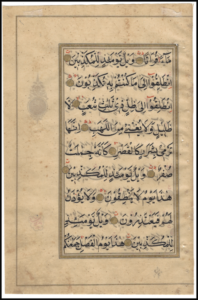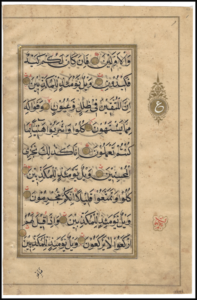Over the next several posts I will highlight items from our library that originate outside the English-speaking world. Within our Manuscripts and Archives many ethnic and linguistic groups are represented. Around the world people have created a wide variety of beautiful, and utilitarian forms of writing to transmit our human heritage. While we do not always know the details of some of our specific specimens, we can appreciate the importance of them to an individual or group of people. Thus, the following posts may not provide a complete analysis or extensive documentation1 of our manuscripts, but we will try to tell something about their provenance and why we are attracted to them.
I am not following any particular method of selecting these items. I am using a, first come first served, grab bag approach. In some ways this type of discovery is more engaging. Also, we will only look at one item per post so that it can receive the consideration it is due.
Now for our first selection:
Our collection includes this leaf containing a Surah from the Qurʾān. A Surah is one of the 114 chapters of the Qurʾān. Surahs are traditionally proclaimed as a part of Muslim prayers. Prior to the 19th century copies of the Qurʾān were created, by hand, in manuscript form. Many examples are known for their beautiful calligraphy and ornate style.
This leaf was created in AH 1140, or in our western calendar AD 17272. The copy of the Qurʾān, that this fragment is from, was made for the Nawab Muhammad Amiu Khau in India. There are nine lines of script3. Each verse is separated by a gold disk and the calligrapher embellished the margins with medallions. This is truly a beautiful example of a Qurʾān produced in India.
—–
DLWA Call Number: AC1 BP130.4.L4243 1727
Worldcat: Link
-
- Title: Medieval Qurʾān manuscript leaf.
- Author: Anonymous
- Language: Arabic
- Setting: Manuscript styles, Qurʾān leaf
—–
- When this series of posts is completed we will do our best to provide bibliographical and analytical resources for delving more deeply into these items. We also reserve the right to update the posts as more information becomes available!
- AH refers to the Hijri year (Arabic: سَنة هِجْريّة) which begins in the western calendar year 662 AD (We will not use the politically correct, misleading, and denialism terms BCE and CE in our works here. We all know what point in time they refer to.)
- Said to be scribed in uaskli script – We still need to verify what script is represented here.
–DLW


